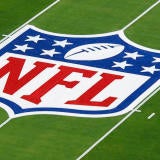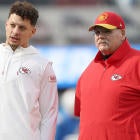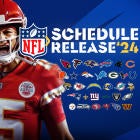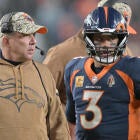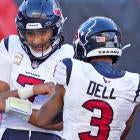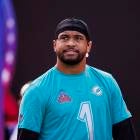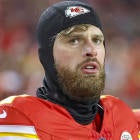 |
| Bill Belichick was at the center of the "Spygate" scandal in 2007, when the Patriots were fined $250,000 and Belichick himself was fined $500,000 for filming opponents' signals on the sideline. On our cheater meter, that rates a 10, which is very similar to a unanimous guilty verdict in a court of law. (US Presswire) |
When the Chargers were accused -- and later exonerated -- of using illegal Stickum against the Broncos a couple of weeks back, it made us think. Cheating in the NFL? It happens. Plenty. But the thing is, it’s not always at bounty scandal proportions. In fact, it’s often just subtle massaging -- not outright cheating at all but, rather, just clever gamesmanship that pushes the legal limits and sometimes inspires rule rewrites. Here are some of our favorite rule-twisting moments from the Super Bowl era:
Oakland Raiders, 1980 -- Lester Hayes' sticky situation
Rule-bender: Raiders CB Lester Hayes started using Stickum as a rookie in 1977 when Hall of Fame wide receiver Fred Biletnikoff introduced him to the gooey substance. But instead of just using a little on his hands to help him hold onto the football, Hayes started slathering it on his hands and arms and even on his uniform, drawing more and more attention to himself and to Stickum. In 1980, Hayes intercepted 13 passes during the regular season and five more in the playoffs as the Raiders went on to win Super Bowl XV. Hayes was named the NFL's Defensive Player of the Year. After that season, the NFL banned Stickum. Cheater meter: 1 -- Stickum wasn't against the rules until 1981, so you can't say Hayes was cheating. But he used the stuff to such a degree that the league adopted the so-called "Lester Hayes rule," making it illegal. He never had more than four interceptions in any of his final six seasons. -- Eric Gilmore
New England Patriots, 2007 -- “Spygate”
Rule-bender: In direct violation of NFL rules, and despite warnings from the league to cease and desist, Bill Belichick and the Patriots spent the early portion of the decade filming their opponents’ signals from the sidelines. They were finally caught with powder on their faces when Eric Mangini, New England’s former defensive coordinator and coach of the Jets at the time, ordered security to confiscate the camera from the Patriots’ sideline. How the videos helped New England is still unclear, but some believe that football savant Ernie Adams, who holds the curious position of Football Research Director, was able to decipher the signals during games and relay the information to the players on the field. Cheater meter: 10 -- Belichick bucked warnings from the league and was fined $500,000, the maximum amount allowed by the league. The Patriots were also hit with a $250,000 fine and stripped of a 2008 first-round pick. -- Nick Underhill
Washington Redskins, 1981-92 -- Joe Gibbs' creative IR list
Rule-bender: No team stashed more players on injured reserve than the Redskins before the rule changed to make IR players ineligible for the rest of the season. One player, when asked what he had hurt, responded, “They told me it was my knee.” This, uh, philosophy enabled the Redskins to develop players such as offensive lineman Ray Brown, among others. The NFL fined the team, but owner Jack Kent Cooke considered it a small price for helping his team. Cheater meter: 7 -- It was against the rules, but if the NFL thought it was so bad it could have penalized the Redskins with more than a small fine; eventually the league did as the IR rules were changed. -- John Keim
 |
| Redskins coach Mike Shanahan is credited with the call-a-timeout-a-split-second-before-the-kicker-tries-a-field-goal-against-your-team tactic. He first used it against the Raiders and Sebastian Janikowski in 2007, when he was head coach of the Broncos. (US Presswire) |
Denver Broncos, 2007 -- Mike Shanahan and the pre-kick timeout
Rule-bender: Before the 2007 season, the NFL tweaked its rules to allow coaches to call timeout from the sideline, so as Oakland's Sebastian Janikowski lined up for a 52-yard field goal 3:47 into overtime, Shanahan wanted to ice him -- but to do so at the most disruptive moment possible. He told line judge Byron Boston that he planned to call timeout, then stood near the official, waiting for the last possible moment before calling it. Since the Denver crowd was deafening, few on the field heard, so players on both teams reacted as though the play was live, and Janikowski drilled the 52-yard attempt. But referee Walt Anderson waved it off, and Janikowski hit the left upright on the rekick. Denver promptly drove 52 yards in nine plays to a game-winning field goal and a 23-20 win. Cheater meter: 1 -- Shanahan never met a loophole he wouldn't try to exploit -- and in this case, he created a gambit that is now standard operating procedure for most college and pro coaches -- even if it's something of an underhanded tactic. -- Andrew Mason
Chicago Bears, 1985 -- Jim McMahon’s head games
Rule-bender: QB Jim McMahon violated the NFL dress code by wearing an “Adidas” headband in a playoff win over the Giants and drew a $5,000 fine for not adhering to the NFL dress code. He then wore one saying “Rozelle” on it to get in a jab at commissioner Pete Rozelle. The commish took it good-naturedly, calling it “funny as hell,” but kept the fine intact. In the Super Bowl, McMahon wore headbands with various causes, including JDF Cure (Juvenile Diabetes Foundation) and Pluto (the nickname of his good friend who had a brain tumor). Cheater meter: 1 -- It didn’t affect the outcome of games, just McMahon's pocketbook. It may have been the first real controversy surrounding the NFL's uniform code, though, and it cemented McMahon's reputation as a rebel. -- Gene Chamberlain
New Orleans Saints, 2012 -- The bounty system
Rule-bender: This was the scandal of all scandals, producing the longest suspensions for coaches in NFL history. From 2009 to 2011, the NFL alleged in charges levied last March, “between 22 to 27” Saints players were involved in a bounty program that gave cash bonuses for inflicting “cart-off” hits that injured players. Former defensive coordinator Gregg Williams had started the program, and players pooled their own money to hand out the performance bonuses. Williams was suspended indefinitely. Saints coach Sean Payton received an unprecedented season-long suspension for allegedly knowing about the bonuses but doing nothing to stop them. Other suspensions: General manager Mickey Loomis (eight games), linebacker Jonathan Vilma (full season) defensive end Will Smith (four games) and former Saints players Scott Fujita (three games) and Anthony Hargrove (eight games). Cheater meter: 9 -- Although the NFL could produce no evidence of any illegal hits that resulted in injury, the intent was the problem. Saints officials lying about it for two years after the initial investigation didn’t help. With impending lawsuits from former players about the league looking the other way to head injuries, Goodell felt compelled to bring down the hammer. -- Guerry Smith
Oakland Raiders, Sept. 10, 1978 -- The Holy Roller
Rule-bender: Trailing San Diego 20-14 with 10 seconds left to play, Raiders quarterback Ken Stabler took the snap at the Chargers' 14, dropped back to pass and was about to be sacked by linebacker Woodrow Lowe when he fumbled the ball forward. Running back Pete Banaszak got the ball at the 12 and, using both hands, pitched it forward as he went down, then tight end Dave Casper, bending over for the ball, batted it from the 5 into the end zone, where he fell on it for a touchdown. Cheater meter: 9 -- After the game, Stabler admitted he fumbled the ball forward on purpose, which was then and still is against the rules. Banaszak clearly fumbled on purpose, too. The "HolyRoller" spurred an NFL rules change, allowing only the player who initially fumbles to advance the ball in the final two minutes of either half. -- Eric Gilmore
(Courtesy of TVSnapFA)
Seattle Seahawks, Jan. 1, 1989 playoffs -- Fake injury farce
Rule-bender: In 1988, the Bengals were famous for running their no-huddle offense between second and third downs so teams couldn’t sub in their nickel packages. In the divisional round of the playoffs, the Bengals met Chuck Knox and the Seahawks. Knox really wanted his nickel package in on third down, so he had his team fake injuries. Knox didn't try to hide the strategy either; DL Joe Nash and DL Ken Clarke went down with injuries six times in the game, all before third downs. Afterward, Don Shula, working for NBC, called it a “farce.” The fake injuries didn’t help, though. The Bengals won 21-13. Cheater meter: 6 -- Several teams since have used the fake injury strategy, but this was one of the first high-profile cases. -- John Breech
San Francisco 49ers, 1997 -- Clark and Policy's side deals
Rule-bender: In 1997, the 49ers drafted QB Jim Druckenmiller in the first round out of Virginia Tech and team executive Dwight Clark made an off-the-books agreement to renegotiate Druckenmiller’s contract if he became a starter within three years. That’s a no-no. The team also allegedly promised TE Brent Jones additional money, outside the salary cap, for work to help the team construct a new stadium. Another big no-no. In 2000, the NFL announced it took away the team’s fifth-round pick in the 2001 draft, its third-round pick in 2002 and fined the team $300,000. Clark was fined $200,000 and his boss, Carmen Policy, was fined $400,000. Cheater meter: 7 -- It didn’t give the 49ers an in-game advantage but was clearly an attempt to circumvent league rules. -- Kyle Bonagura
 |
| Chiefs defensive tackle Shaun Smith was accused of groin grabbing in 2010. (US Presswire) |
Kansas City Chiefs, 2010 -- The “nut grabbing” scandal
Rule-bender: The rulebook doesn't have any specifics on this offense, but Shaun Smith violated the man code the first two weeks of 2010 when he allegedly went groin grabbing. Cleveland's Alex Mack and San Francisco's Anthony Davis said Smith felt their packages. Davis, not Smith, was penalized for his retaliation. The Chiefs and Smith parted ways after the 2010 season, but at 1-7 and hoping to grab a win somehow, they signed KC's favorite nutcracker this week. Cheater meter: 8 -- Such a violation would be worthy of an ejection at any establishment and probably should be in a football game, in addition to a very-unsportsmanlike penalty. -- C.J. Moore
Baltimore Ravens, 2012 -- John Harbaugh vs. the injury report
Rule-bender: Through seven games this season, Harbaugh and the Ravens were only disclosing injuries that caused players to miss practice time. The NFL rule states that teams must release injury information for all players, even if they don’t miss any practice reps. Once Ed Reed let it be known that he had torn his labrum without being listed on the injury report, the NFL investigated and fined the Ravens $20,000. Cheater meter: 3 -- It’s not much of a violation considering he wasn’t hiding injuries from players who couldn't participate in practice. But if all teams are disclosing injuries, the Ravens must as well. -- Jason Butt
Baltimore Ravens, 2010 -- Workin’ overtime
Rule-bender: Though there are regulations about how tough you can practice during offseason organized team activities, the Ravens pushed the tempo and intensity on their players in the heat of the summer of 2010. After players complained to the NFL, the Ravens were found guilty and had the last week of OTAs taken away. Cheater meter: 5 -- The Ravens were trying to gain a competitive advantage by getting a head start on in-game simulation without the rest of the league knowing. However, getting caught temporarily embarrassed the organization. -- Jason Butt
Minnesota Vikings, 1990s -- No wonder the roof fell in
Rule-bender: During the 1990s, the Minnesota Vikings’ game operations crew was accused of making the already loud Metrodome even louder. They reportedly pumped in extra crowd noise during opponents’ offensive series, making play calls and audibles nearly impossible. Cheater meter: 3 -- It may have caused a few false starts and given everyone in attendance tinnitus for the following week, but it was hard to validate the claims --and teams adjusted with silent counts. -- Joe Oberle
Indianapolis Colts, 2007 -- Turn it up
Rule-bender: After an early season game, Patriots brass accused the Colts of pumping artificial crowd noise into the RCA Dome. A grainy YouTube video published after the game recorded what appeared to confirm fake noise being played over the loudspeaker, evidenced by what sounds like a CD skipping. The Colts were eventually exonerated as CBS released a statement attributing the noise to an audio malfunction on the telecast. Cheater meter: 1 -- The conspiracy lives on to this day, but the purported extra crowd noise didn't seem to bother Tom Brady and Bill Belichick; the Pats won 24-20. -- Evan Hilbert
Miami Dolphins, 1970 -- Joe Robbie gets his man
Rule-bender: Robbie, the Dolphins owner at the time, approached then-Baltimore Colts coach Don Shula to lead his team in South Beach following the 1969 season. Shula opted to flee Baltimore for the sandy beaches, and Robbie clearly violated the league’s anti-tampering rules, costing his team a first-round draft pick. But it was worth it: Miami played in three of the next four Super Bowls, winning two, including the 17-0, 1972 season. Cheater meter: 7 -- Every team tampers to some degree, but Robbie stopped at no cost to get his man. And the Colts surely wish they’d have gotten more than a first-round pick. -- Dave Carey
New York Jets, 2010 -- A real trip
Rule-bender: When the Jets hosted the Dolphins on December 12, 2010, then strength coach Sal Alosi had inactive players construct a now-infamous "wall" on the sideline to prevent any Dolphins from going out of bounds on punt returns. Alosi then took it one step further, sticking his knee out and tripping Dolphins returner, CB Nolan Carroll. Carroll was unhurt, but after a huge outcry, Alosi was suspended from the team and then resigned. He is now the strength and conditioning coordinator for UCLA’s football team. Cheater meter: 9 --The wall has been used by many teams, but a coach on the sideline tripping a player? Bad sportsmanship -- really bad -- any way you look at it. -- Lisa Zimmerman
(Courtesy of littleisrael)
Buffalo Bills, 2012 -- Injury? What injury?
Rule-bender: Just a few weeks ago, the Bills were fined $20,000 for failing to disclose star DE Mario Williams’ left wrist injury on their official injury report. Williams constantly cited the injury as a reason for his disappointing start, and it was actually first mentioned by coach Chan Gailey -- but the Bills never saw the need to list him on the report as he practiced and played through the injury. The league thought otherwise. The Bills have pulled a page out of Bill Belichick’s book in response -- they had a whopping 21 players listed on the injury report for Week 9 (including Williams). Cheater meter: 4 -- It was enough to draw a fine from the league, but it’s not that big of a deal in the grand scheme of things. -- Mark Ludwiczak
Cincinnati Bengals, 1988 -- Levy challenges the no-huddle
Rule-bender: What Sam Wyche and the potent 1988 Bengals offense did wasn't illegal. More than anything, it was groundbreaking -- they invented the modern day no-huddle offense. Yet, one day before the AFC Championship against Buffalo, Marv Levy's complaining about the no-huddle and substitution patterns of Wyche's attack caused the league to deem it illegal for that critical game. Even without the benefit of the no-huddle, Cincinnati won, and the NFL reversed the ruling before that year's Super Bowl. (The Bengals lost to the 49ers). Cheater meter: 1 -- Finding a team that doesn't use the no-huddle in some capacity these days is impossible, but at the time it pushed conventional interpretation of the rules. -- Paul Dehner
Cleveland Browns, mid-1970s -- Greg Pruitt's flimsy tear-away jersey
Rule-bender: OK, it wasn’t really cheating because the NFL had no rules against it until the scatback began frustrating and angering would-be tacklers. Greg Pruitt wore a tear-away jersey that pretty much disintegrated when grabbed. Defenders found it difficult enough to get a hold of the elusive Pro Bowler without winding up with a handful of jersey as he scampered away. The NFL eventually banned the tear-away in a direct response to complaints about Pruitt. Cheater meter: 1 -- Was it really cheating when it was legal at the time? Sort of, because Pruitt knew he was getting away with something. But let's just call it a small error in judgment that allowed him to exceed 1,000 yards rushing. -- Marty Gitlin
Philadelphia Eagles, 1989 -- Buddy Ryan’s “Polish punt team’’
Rule-bender: The Eagles were leading the Minnesota Vikings 10-9 lead late in the fourth quarter and were forced to punt when coach Buddy Ryan sent out 14 men to make sure there would be no blocked punt or long return. Ryan figured the Eagles would be penalized and the Vikings could decline the penalty, which meant the Eagles got great coverage and favorable field position, or they could accept the penalty and the Eagles would have to punt again from five yards back. To Ryan, the five yards meant nothing, but the precious seconds that ticked off the clock meant everything. To his chagrin, the officials didn’t notice the Eagles had three extra guys strolling around the field and no flag was thrown. After the game, Ryan fumed that if he had known the officials wouldn’t see it, he would have sent out 15 men. Cheater meter: 7 -- It just wasn’t very sportsmanlike. -- Kevin Noonan
Philadelphia Eagles, 1986 -- Buddy Ryan and the “Throw-up”
Rule-bender: Perhaps Ryan’s most ingenious maneuvering around the NFL rulebook came during a 1986 game against the Denver Broncos. Ryan and/or somebody on his staff noticed that the Broncos assigned to block the “gunners’’ on the Eagles’ punt coverage team always turned their backs at the snap and ran downfield to set up their blocks for the return. So Ryan had his punter, John Teltschik -- a terrific all-around athlete -- pull a fast one. Teltschik took the snap and threw the ball high in the air in a long, lazy arc – just like a punt. The Broncos’ blockers started hammering the Eagles’ gunners, of course, but now this wasn’t blocking, it was pass interference. Sure enough, the officials threw the flag and the Eagles got a first down. However, it didn’t do Buddy any good; the Eagles ended up getting stomped by the Broncos 33-7. Cheater meter: 0 -- Ryan didn’t break any rules, and he gets all sorts of bonus points for creativity. -- Kevin Noonan
 |
| Giants middle linebacker Jacquian Williams got the finger pointed at him last season by Rams LB Bryan Kehl, a former Giant. The charge: faking an injury to stop the clock. (US Presswire) |
New York Giants, 2011 -- Taking a dive for the team
Rule-bender: In Week 2 of the 2011 season, the Giants were accused of some gamesmanship by a former teammate. Facing the St. Louis Rams’ no-huddle offense, Giants LB Jacquian Williams suddenly hit the ground in an apparent effort to stop the clock and get a breather. Former Giants LB Bryan Kehl told the media afterward that defensive coordinator Perry Fewell had instructed his players to fake an injury whenever a no-huddle offense was advancing the ball like St. Louis was at the time. Cheater meter: 3 -- The Giants never admitted to anything, but the strategy has been used throughout the league at various times. -- Alex Raskin
Atlanta Falcons, 2012 -- Cheating the replacement refs?
Rule-bender: With the Falcons up 27-21 over Denver late in the fourth quarter and facing a third-and-five from their own 25-yard line, WR Roddy White knowingly committed offensive interference to clear out space for a 6-yard conversion -- at least according to a Denver Post writer. WR Julio Jones, who converted the first down, was the “beneficiary of the Falcons’ disregard for the rules in a situation where replacement officials would naturally be hesitant to make a crucial call certain to be unpopular with the home crowd,” Mark Kiszla wrote. Cheater meter: 2 -- Not a major infraction, but a good example of how carefully the Falcons study the tendencies of each referee. “We have six years of data on what officials call,” coach Mike Smith said earlier this year. -- Mike Singer
San Diego Chargers, 2012 -- Norv Turner and the Stickum towel
Rule-bender: The Chargers were accused of using illegal stickum in their 35-24 loss to the Broncos on Monday Night Football in Week 6. Coach Norv Turner maintained no illegal substance was used. Turner insisted the only thing in question was a towel that he claimed is widely used throughout league to dry hands and game balls. After a four-week investigation, the NFL determined that the Chargers did not violate any competitive rules. However, a member of the Chargers training staff failed to immediately cooperate with an official after being given a clear directive to hand over the towel. Instead, he ignored the official and attempted to conceal the towel. As a result, the Chargers were fined $20,000 for failure to follow the directive of a game official. Cheater meter: 2 -- The fine could have been stiffer for the purpose of sending a stronger message that it never pays to cover something up, even when you’re not doing anything wrong. -- Dan McLellan
Detroit Lions, 2009 -- Eric Mangini vs. Jim Schwartz
Rule-bender: The Browns used an aggressive no-huddle offense to take a 24-3 lead over the Lions in Week 11 of the 2009 season, until their speed-based attack was disrupted by several Lions who required medical attention on the field before quickly returning to action. After Detroit’s 38-37 comeback win, then Cleveland coach Eric Mangini hinted that the Lions’ “injuries” weren’t quite as serious as they seemed. Lions coach Jim Schwartz, who worked alongside Mangini under master gamesman Bill Belichick, flatly denied Mangini’s speculations. Cheater meter: 3 -- It’s nearly impossible to substantiate Mangini’s claims about the Lions’ injuries, or lack thereof. The only reason the episode pops up on our radar is that then-Browns’ WR Chansi Stuckey told reporters that Cleveland, whose coach learned from the same master as Schwartz, would have faked injuries in a similar manner if the roles were reversed. -- John Kreger
Follow Raiders reporter Eric Gilmore on Twitter @CBSRaiders; Follow Nick Underhill's Patriots' coverage on Twitter @CBSPats or @nick_underhill; Follow John Keim's Redskins coverage on Twitter @CBSRedskins or @John_Keim; Follow Bears reporter Gene Chamberlain on Twitter @CBSBears; Follow Saints reporter Guerry Smith on twitter @CBSSaints; For more up-to-the-minute news and analysis from Seahawks blogger John Breech follow @CBSSeahawks and @JohnBreech; Follow 49ers reporter Kyle Bonagura on Twitter: @CBS49ers and @KyleBonagura; Follow Chiefs reporter C.J. Moore on Twitter @CBSChiefs and @cjmoore4; Follow Ravens reporter Jason Butt on Twitter: @CBSRavens and @JasonButtCBS; For more Vikings news and notes, follow Joe Oberle on Twitter @CBSVikings; For more up-to-the-minute news and analysis from Colts blogger Evan Hilbert, follow @CBSSColts; For more up-to-the-minute news and analysis on the Dolphins from blogger Dave Carey, follow @CBSDolphins; Stay dialed in on the Jets by following correspondent Lisa Zimmerman on Twitter @CBSJets and @LisaZimmerman; For more updates on the Bills, follow correspondent Mark Ludwiczak on Twitter @CBSBills and @MarkLud12; Follow Paul Dehner Jr. for Bengals updates on Twitter at @CBSBengals; Stay dialed in on the Browns on Twitter at @CBSBrowns throughout the season with on-site updates from CBSSports.com RapidReports correspondent Marty Gitlin; For more up-to-the-minute news and analysis on the Eagles from blogger Kevin Noonan, follow @CBSEagles; Follow the Giants and Alex Raskin @CBSGiants and @AlexRaskinNYC; For more Falcons coverage, follow Mike Singer @CBSSportsNFLATL; Follow Lions reporter John Kreger on Twitter at @CBSLions and @JohnKreger; Follow the Chargers and Dan McLellan on Twitter @CBSChargers and @sandiegosports.







